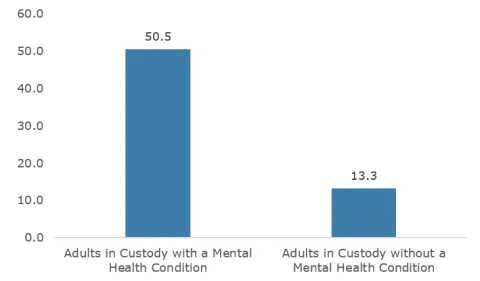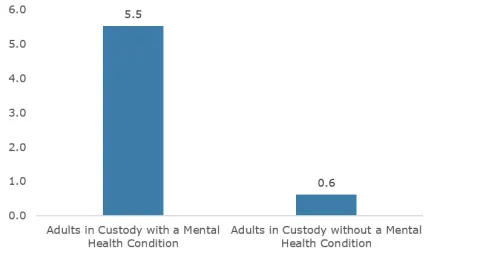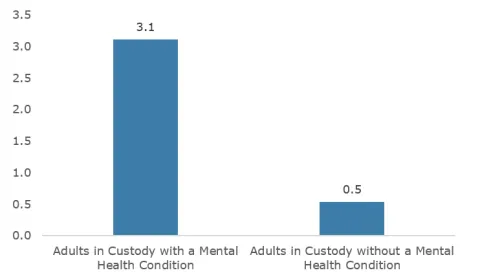Jail conditions were worse for people with mental health conditions
The state did not establish jails to serve as facilities for housing people with mental health conditions, nor are jails an ideal place to treat mental health conditions. However, the reality is that many people in jail need mental health treatment, or at a minimum, need help to keep their conditions from deteriorating. And, where we found shortcomings in the Sheriff’s Office’s operation of the jails, in terms of classification, discipline, and use of force, the effect was most pronounced for those who have mental health conditions.
Insufficient specific housing for people with mental health conditions
Specific housing for people with mental health conditions was very limited, meaning that even if an individual was classified properly as having these challenges, they may not get housing and attention that are more appropriate for their condition. The mental health specialists within the jails told us that they have 10 cells within the psych dorm and 16 additional cells in the acute mental health unit. The closer the jails are to their maximum capacity, the greater the challenge for the Sheriff’s Office to address housing needs.
Mental health specialists told us they could easily use twice as much specialty housing for these people. On average, 44% of adults in custody have a known mental health condition; these are individuals who have a known history of mental health issues from previous jail stays. People who classification staff have identified as having mental health conditions have the letters “MH” on their dorm card outside of their housing, and because of this, deputies should know which adults in custody have known mental health conditions. During our three-year review period, this was anywhere between 300 and 500 people each day.
Since the Sheriff’s Office data only reflected individuals who had been housed in the jails previously, this was likely an undercount of the actual number of individuals with mental health conditions. We compared the Sheriff’s Office data to data on individuals enrolled in programs for people needing intensive mental health services provided by the county’s behavioral health division to see if these people were included in the Sheriff’s data. We identified 117 people who were not included in the Sheriff’s data, accounting for about 2% percent of the total. We then included these people in our analysis.
With the reduced jail population during the COVID-19 pandemic, the Sheriff’s Office had more flexibility in where they housed individuals. As a result, they added a dormitory in the Inverness Jail specifically for individuals with mental health conditions who would benefit from an environment with fewer restrictions than found in MCDC. While they added housing, the number of budgeted staff at the Sheriff’s Office and the Corrections Health unit that specialize in working with this population did not increase.
The discipline system was challenging for those with mental health conditions
The discipline system was also particularly problematic for people with mental health conditions during the three-year period we reviewed. Mental health and corrections experts have found that it is common for people with mental health conditions to find it very difficult to follow strict rules and to be likely to break rules when stressed. During the three-year period we reviewed, we found that when Sheriff’s staff determined these individuals had broken rules, they were then frequently placed in isolation. This has been shown to be harmful even for people without mental health conditions and was particularly harmful for those who do.
The National Commission on Corrections Health stated that it was well established that people with serious mental health conditions were particularly vulnerable to the harms of being deprived on meaningful contact with others. As a result, federal courts have repeatedly found the most restrictive levels of isolation of people with serious mental health conditions to be unconstitutional. The Commission recommended that individuals with serious mental health conditions be excluded from the most restrictive levels of isolation for any duration.
When we looked at discipline data for the three-year period, we found that deputies disproportionately gave misconduct citations to people with mental health conditions. Most discipline sanctions resulted in an isolation sanction. This resulted in 19% of those with mental health conditions spending time in isolation, compared with 7% of those without mental health conditions.
Corrections staff gave misconduct citations at a higher rate to adults in custody who have mental health conditions
Number of misconduct citations per 100 people housed in jail

Corrections staff used force more often on adults in custody who have mental health conditions
Being subjected to misconduct citations can also lead to use of force, something that people with mental health conditions were also disproportionately subjected to. Receiving a misconduct citation frequently involves being moved into a different cell in disciplinary housing. When individuals resist the move, Sheriff’s Office staff use force to move the individual – in some cases, staff used pepper spray or Tasers to gain compliance. The move to disciplinary housing also involves a strip search when brought into the new cell. Individuals who resist the search are held while their clothing is cut off. The trauma of the move, followed by isolation is particularly harmful for people with mental health conditions.
We found that deputies used force on individuals with mental health conditions more than on those without mental health conditions, for both general and minor uses of force. The differences in use of force were statistically significant, which means that there was a very low likelihood that the differences were due to chance.
General uses of force were infrequent, but adults in custody with mental health conditions were about nine times more likely to be subjected to them
Number of general uses of force per 100 people housed in jail

Minor uses of force were infrequent, but adults in custody with mental health conditions were about six times more likely to be subjected to them
Number of minor uses of force per 100 people housed in jail

The National Institute of Corrections addressed the issue of planned use of force (for example, when someone needs to be moved to a different dorm against their will) on individuals with mental health conditions, recommending that these events be recorded on video. It included that prohibitions against the use of pepper spray and Tasers for adults with mental health conditions in custody were becoming more common. The Sheriff’s Office implemented the recommendation for video recording of planned use of force events in October 2021. The implementation also requires staff to document all de-escalation efforts as well as any participation by medical staff. In terms of use of force on individuals who have mental health conditions, the Sheriff’s Office policies do not prohibit the use of pepper spray or Tasers.
